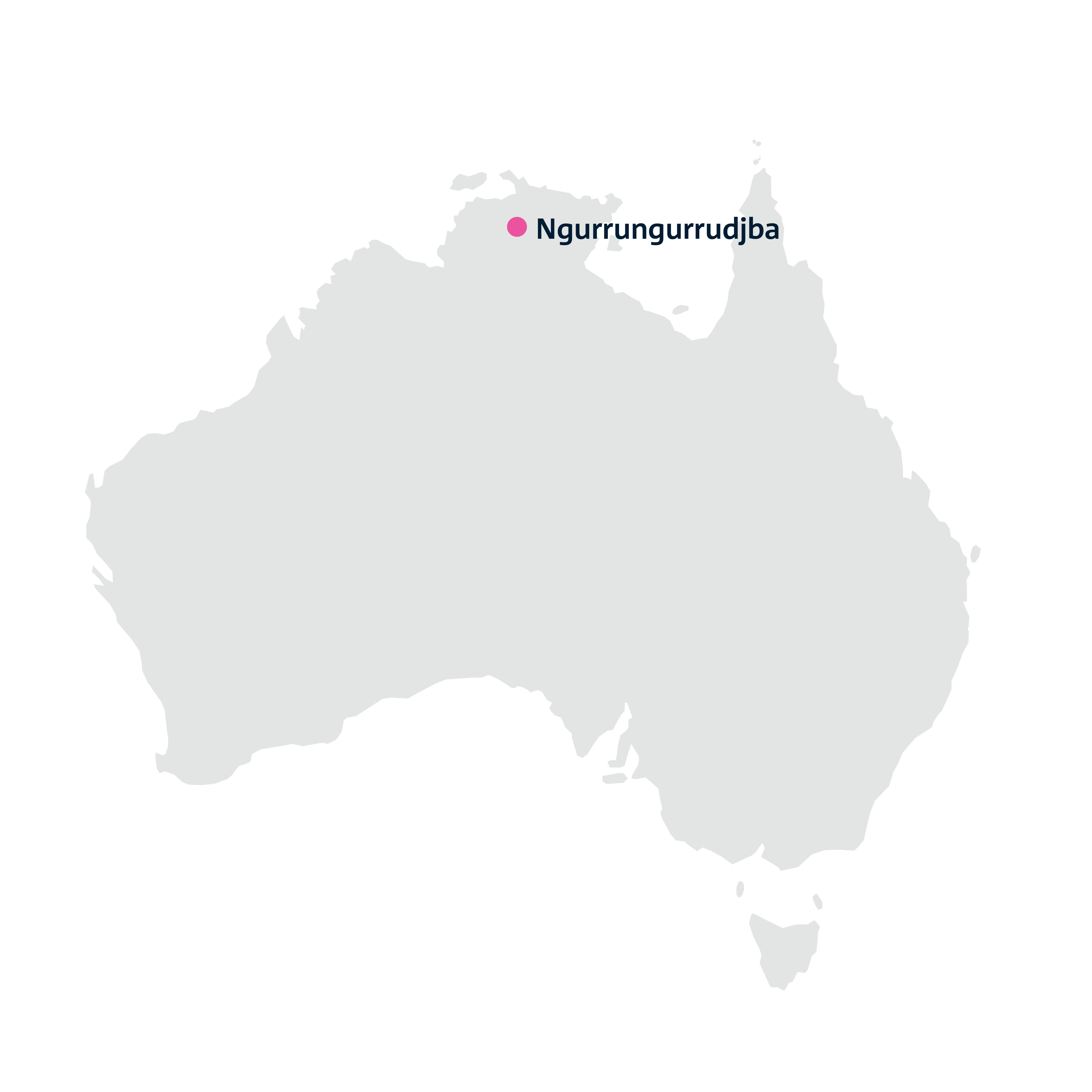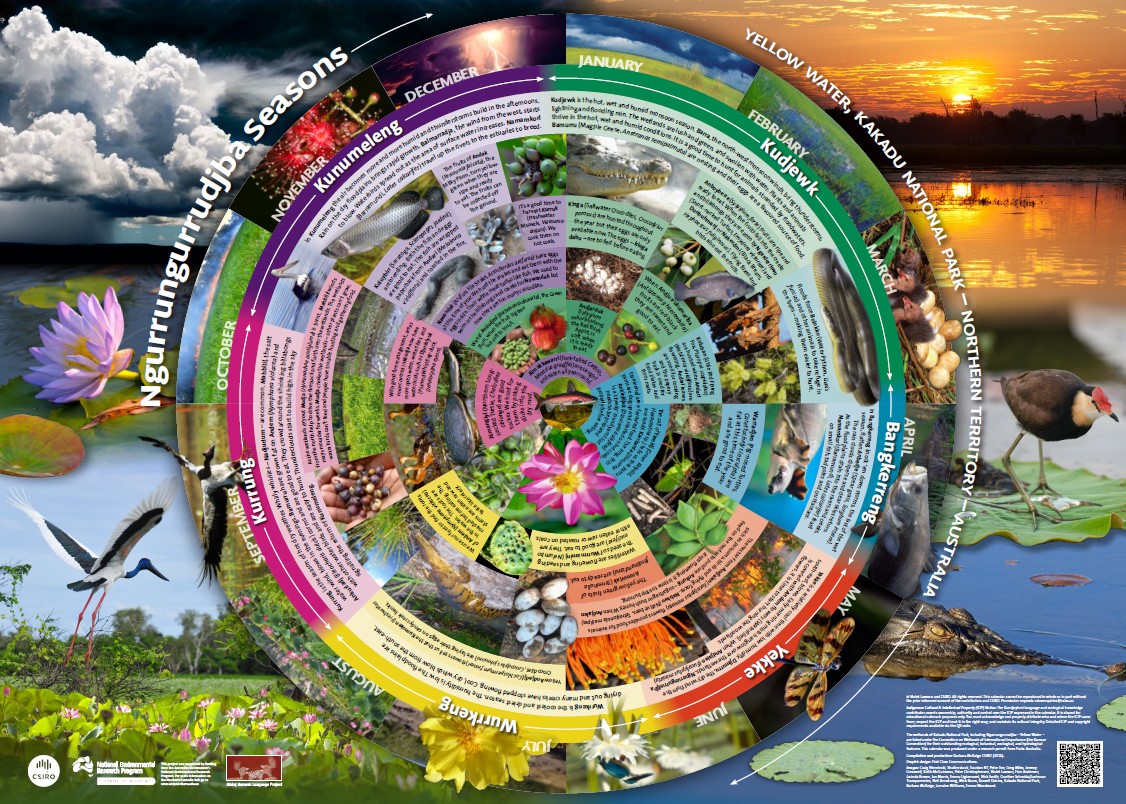 CSIRO worked with Violet Lawson, a Traditional Owner from the Ngurrungurrudjba (Yellow Water) region in Kakadu National Park in the Northern Territory, to document Kundjeyhmi knowledge of the seasons and the environment in a calendar1.
CSIRO worked with Violet Lawson, a Traditional Owner from the Ngurrungurrudjba (Yellow Water) region in Kakadu National Park in the Northern Territory, to document Kundjeyhmi knowledge of the seasons and the environment in a calendar1.
The wetlands of Kakadu, including Ngurrungurrudjba, are listed under the Convention on Wetlands of International Importance (the Ramsar Convention) for their outstanding ecological, botanical, zoological, and hydrological features.
Ms Lawson's calendar documents ecological knowledge about Ngurrungurrudjba that has been passed down to her from her mother, preserving it for future generations. The Ngurrungurrudjba calendar also means that important cultural knowledge is now accessible to the tens of thousands of people who visit Kakadu each year.
The calendar was developed as part of the National Environmental Research Program’s Northern Australia Hub and with support from the Bininj Gunwok Language Project.
Ngurrungurrubjdar seasons calendar

Ngurrungurrudjba seasons
Kudjewk
Kudjewk is the hot, wet and humid monsoon season. Barra, the north-west monsoon winds, bring thunderstorms, lightning and flooding rain. The wetlands are lush and green, and swollen with water. Plants and animals thrive in the hot, wet and humid conditions. It is a good time to hunt for animals stranded by floodwaters. Bamurru (Magpie geese, Anseranas semipalmata) are nesting and their eggs are a favoured source of food.
Bangkerreng
In Bangkerreng knock 'em down storms, the last of the wet season, flatten Anbedje (Spear grass, Sorghum intrans). The rain clouds disperse and clear skies return. As the floodplains drain into the rivers and creeks, Namarnkorl (Barramundi, Lates calcarifer) feast on small fish, tadpoles and crustaceans.
Yekke
Yekke is a relatively cool time with low humidity. Djimurru, the dry wind from the south-east, blows. Early morning mists hang low over the wetlands. Ngurrungurrudjba is covered with Andem (waterlily) flowers. When Andjalen (Eucalyptus miniata) flowers, it is time to start burning the woodlands.
Wurrkeng
Wurrkeng is the coolest and driest season. The humidity is low. The floodplains are drying out, and many creeks have stopped flowing. Cool, dry winds blow from the south-east. Yellow Andjedj (Cochlospermum fraseri) flowers tell us that the Kumoken (Freshwater Crocodiles, Crocodylus johnsoni) are laying their eggs on sandy creek banks.
Kurrung
Kurrung is the season of hot dry weather. Whirly whirlies – Nadjurlum – are common. Mahbilil, the salt water wind, blows in the evenings. Bamurru have grown fat on Andem (Nymphaea violacea) and Ankurladj (Eleocharis dulcis) corms and are good to eat. They crowd around the shrinking billabongs with other water birds and are easy to hunt. Thunderclouds start to build high in the sky signalling the return of Kunumeleng.
Kunumeleng
In Kunumeleng the air becomes more and more humid and thunderstorms build in the afternoons. Rain on the dry floodplains brings bring rapid growth. Balmarradja, the wind from the west, starts to blow. Waterbirds spread out as the area of surface water increases. Namarnkorl (Barramundi) travel up the rivers to the estuaries to breed.
Citation
- Violet Lawson and Barbara McKaige (2016) Ngurrungurrudjba (Yellow Water) Seasons, Kakadu National Park, Northern Territory, Australia. CSIRO (Land and Water)
CSIRO worked with Violet Lawson, a Traditional Owner from the Ngurrungurrudjba (Yellow Water) region in Kakadu National Park in the Northern Territory, to document Kundjeyhmi knowledge of the seasons and the environment in a calendar1.
The wetlands of Kakadu, including Ngurrungurrudjba, are listed under the Convention on Wetlands of International Importance (the Ramsar Convention) for their outstanding ecological, botanical, zoological, and hydrological features.
Ms Lawson's calendar documents ecological knowledge about Ngurrungurrudjba that has been passed down to her from her mother, preserving it for future generations. The Ngurrungurrudjba calendar also means that important cultural knowledge is now accessible to the tens of thousands of people who visit Kakadu each year.
The calendar was developed as part of the National Environmental Research Program’s Northern Australia Hub and with support from the Bininj Gunwok Language Project.
Ngurrungurrubjdar seasons calendar
Ngurrungurrudjba seasons
Kudjewk
Kudjewk is the hot, wet and humid monsoon season. Barra, the north-west monsoon winds, bring thunderstorms, lightning and flooding rain. The wetlands are lush and green, and swollen with water. Plants and animals thrive in the hot, wet and humid conditions. It is a good time to hunt for animals stranded by floodwaters. Bamurru (Magpie geese, Anseranas semipalmata) are nesting and their eggs are a favoured source of food.
Bangkerreng
In Bangkerreng knock 'em down storms, the last of the wet season, flatten Anbedje (Spear grass, Sorghum intrans). The rain clouds disperse and clear skies return. As the floodplains drain into the rivers and creeks, Namarnkorl (Barramundi, Lates calcarifer) feast on small fish, tadpoles and crustaceans.
Yekke
Yekke is a relatively cool time with low humidity. Djimurru, the dry wind from the south-east, blows. Early morning mists hang low over the wetlands. Ngurrungurrudjba is covered with Andem (waterlily) flowers. When Andjalen (Eucalyptus miniata) flowers, it is time to start burning the woodlands.
Wurrkeng
Wurrkeng is the coolest and driest season. The humidity is low. The floodplains are drying out, and many creeks have stopped flowing. Cool, dry winds blow from the south-east. Yellow Andjedj (Cochlospermum fraseri) flowers tell us that the Kumoken (Freshwater Crocodiles, Crocodylus johnsoni) are laying their eggs on sandy creek banks.
Kurrung
Kurrung is the season of hot dry weather. Whirly whirlies – Nadjurlum – are common. Mahbilil, the salt water wind, blows in the evenings. Bamurru have grown fat on Andem (Nymphaea violacea) and Ankurladj (Eleocharis dulcis) corms and are good to eat. They crowd around the shrinking billabongs with other water birds and are easy to hunt. Thunderclouds start to build high in the sky signalling the return of Kunumeleng.
Kunumeleng
In Kunumeleng the air becomes more and more humid and thunderstorms build in the afternoons. Rain on the dry floodplains brings bring rapid growth. Balmarradja, the wind from the west, starts to blow. Waterbirds spread out as the area of surface water increases. Namarnkorl (Barramundi) travel up the rivers to the estuaries to breed.
Citation
- Violet Lawson and Barbara McKaige (2016) Ngurrungurrudjba (Yellow Water) Seasons, Kakadu National Park, Northern Territory, Australia. CSIRO (Land and Water)
